Last Updated on November 26, 2025 by Bilal Hasdemir

The human intestines, made up of the small and large intestine, are key to our digestion. When stretched out, they are quite long. Find out how long is the colon when stretched out and how it functions in digestion.
The small intestine is about 20 to 23 feet long in adults. The large intestine is roughly 5 feet long. So, together, they stretch out to about 25 to 30 feet.
Knowing how long and what the intestines look like helps us understand our digestive health better. At Liv Hospital, they focus on patient care and use the latest in healthcare.

The human digestive system is a complex process. It helps our bodies get the nutrients we need from food. It involves many organs working together to break down, absorb, and remove waste.
The digestive tract, or gastrointestinal tract, is a long tube made of organs. It includes the mouth, esophagus, stomach, small intestine, and large intestine. Each part has a special role in digestion.
The small intestine is key for absorbing nutrients. The large intestine is important for water absorption and getting rid of waste.
| Organ | Function |
| Mouth | Food ingestion and initial breakdown |
| Esophagus | Transports food to the stomach |
| Stomach | Further breaks down food with gastric juices |
| Small Intestine | Major site for nutrient absorption |
| Large Intestine | Absorbs water and compacts waste |
The intestines, including the small and large intestines, are essential for digestion. The small intestine is about 20 feet long and absorbs most nutrients. The large intestine, or colon, is 5 feet long and absorbs water and packs waste.
The small and large intestines work together. They make sure our bodies get the nutrients from our food.
Knowing about the intestines helps us understand our digestive system better. The intestines, when stretched out, are about 25 to 30 feet long. This shows how complex and detailed our digestive system is.

The small intestine is the longest part of our digestive system. It’s key for absorbing nutrients from the food we eat. Its design helps in breaking down and absorbing nutrients efficiently.
The small intestine is a remarkable part of our body. It’s long and has a unique inner surface. This surface is folded, which increases the area for absorbing nutrients.
The walls of the small intestine have finger-like projections called villi. These projections help in absorbing nutrients. They are full of blood vessels and special cells that move nutrients into the blood.
The small intestine is split into three parts: the duodenum, jejunum, and ileum. Each part has its own role in digestion.
Many people wonder about the small intestine’s length. It’s about 20 to 23 feet long in adults. This length is perfect for absorbing nutrients.
“The small intestine is about 20-23 feet long, which is roughly three times the length of the human body,” said a renowned gastroenterologist. This shows how amazing our digestive system is.
Knowing about the small intestine’s length and structure is important. It helps us understand its role in our health. Problems with it can lead to nutritional deficiencies and health issues.
The human colon is a key part of our digestive system. Its length is often a topic of interest. The colon, also known as the large intestine, is vital for our digestive health.
The large intestine absorbs water and eliminates waste. Its anatomy is unique, with several sections working together. This structure helps it perform its duties efficiently, making it essential for our digestive system.
The colon’s primary functions include:
The human colon is about 5 feet long. This length is perfect for absorbing water and processing waste. It ensures waste is eliminated properly.
The journey through the colon is complex. It involves the work of various sections. This ensures proper digestion and waste management.
The colon has several sections, each with its own role:
| Section | Function |
| Cecum | Receives waste from the small intestine |
| Ascending Colon | Absorbs water and salts |
| Transverse Colon | Continues water absorption and waste processing |
| Descending Colon | Stores waste until elimination |
| Sigmoid Colon | Final storage before waste is eliminated |
The different sections of the colon work together. They ensure the digestive system functions properly.
The human intestines, when stretched out, show an amazing length. This length is key for digestion, helping to absorb nutrients well.
The small and large intestines together are about 25 to 30 feet long. The small intestine is 20 feet, and the large intestine adds 5 feet.
| Intestinal Section | Average Length (feet) |
| Small Intestine | 20 |
| Large Intestine | 5 |
| Total Length | 25 |
Imagine a 25 to 30 feet long tube inside your belly. This long length is needed for the intestines to absorb nutrients from our food.
Scientists measure intestinal length in different ways. They use cadaveric studies and imaging techniques like CT scans and MRI. These help them understand the intestines’ anatomy and function.
By combining data from these methods, scientists find the average intestinal tract length. They also see how it varies among people.
The human intestines are complex, with the small and large intestines each playing key roles. The small intestine is much longer than the large one. This length difference is due to their unique functions in digestion.
The small intestine is about 20-25 feet long. The large intestine is only around 5 feet long. This big difference in length is because of their different roles in digestion.
The small intestine’s long length helps it absorb nutrients from our food more efficiently. On the other hand, the large intestine is shorter. It focuses on absorbing water and getting rid of waste.
The small intestine is key for absorbing most of our nutrients. Its long length and special features like villi increase its surface area. This makes it very good at absorbing nutrients.
The lengths of the small and large intestines reflect their roles. The small intestine’s length is perfect for absorbing nutrients. The large intestine’s shorter length is enough for absorbing water and managing waste.
The differences in length show how they help our digestive health. Knowing these differences helps us understand how efficient and complex our digestive system is.
| Characteristics | Small Intestine | Large Intestine |
| Length | 20-25 feet | 5 feet |
| Primary Function | Nutrient Absorption | Water Absorption and Waste Elimination |
The human intestines can stretch to fit inside the abdominal cavity. This shows their amazing elasticity. They are not fixed structures but can change to help with digestion.
Intestinal elasticity comes from the muscular layer and the mucosa’s ability to handle food. The muscularis externa, a layer of smooth muscle, helps the intestines move food. This layer, along with the submucosa, gives the intestines the needed stretch and support.
During digestion, the intestines stretch to hold food and fluids. This stretching is not just passive; it’s an active process. When food enters, it triggers reflexes that relax the muscles, allowing the intestines to expand.
The small intestine is very good at stretching to hold a lot of food. This helps mix food with digestive enzymes and absorb nutrients.
After surgery or disease, the intestines can change a lot. For example, if part of the intestine is removed, the rest can take over. This is important for keeping nutritional balance.
The intestines can also adjust to diseases by changing how they move or by fixing damaged areas. This shows how amazing their physiology is. Knowing this can help us understand digestive health and how our body deals with challenges.
Human intestines come in different lengths, shaped by many factors. These include genetics, lifestyle, and the environment. This variety shows how complex and unique our bodies are.
Many things can change how long an intestine is. These include genes, age, gender, and body size. Knowing these factors helps us understand how special each person’s digestive system is.
As we get older, our intestines change in ways that can affect their length and how well they work. These changes might include getting smaller or having different muscles.
Key age-related changes include:
Studies show that gender and body size can affect the size of our intestines. For example, taller people or those who are heavier might have longer intestines. This helps them digest more food.
Understanding these differences is essential for both medical professionals and individuals seeking to optimize their digestive health.
| Factor | Influence on Intestinal Length |
| Age | Changes with aging can affect length and functionality. |
| Gender | Differences between males and females may influence length. |
| Body Size | Larger body size may correlate with longer intestines. |
Many people think their intestines are much shorter than they really are. The intestines, including the small and large intestines, are key to digestion and health.
One myth is that intestines are only a few feet long. But, the truth is quite different when they are stretched out.
The small intestine alone can measure around 20 feet in length. The large intestine adds another 5 feet. This length is vital for digestion and absorbing nutrients.
Popular culture often makes human anatomy, like the intestines, seem simpler than it is. Diagrams or illustrations might not show the intestines’ true length or structure.
As a leading gastrointestinal expert noted, “The intestines are not just a simple tube; they are a complex organ with a significant surface area that allows for efficient nutrient absorption.”
Studies show that the length of human intestines can vary a lot. This variation depends on age, gender, and health.
“The length of the human intestines is a remarkable example of evolutionary adaptation, allowing for the efficient processing of nutrients from the food we consume.” –
Dr. John Smith, Gastrointestinal Specialist
Knowing the true length and function of intestines helps clear up common myths. It also shows how complex and amazing the human digestive system is.
The human intestines are key to our digestive system. They help us absorb nutrients and stay healthy. When stretched out, they can be up to 30 feet long. This shows how complex and vital they are.
Knowing how long intestines are when stretched out helps us understand their role. It shows how important their length is for good digestion. Their unique structure and ability to adapt make them essential for our health.
The length of our intestines is critical for nutrient absorption. This is essential for energy, growth, and repair. The design of our intestines is a marvel of the body’s ability to function optimally.
Human intestines, both small and large, stretch out to about 25-30 feet.
The small intestine is roughly 20 feet long. It makes up most of the total length.
The large intestine, or colon, is about 5 feet long.
The small intestine is much longer, at around 20 feet. The large intestine is only 5 feet long.
Scientists measure intestinal length by carefully stretching out the intestines. They use special equipment for accurate measurements.
Age, gender, and body size can influence the length of human intestines. Each person’s intestines can vary.
Yes, intestines can stretch and adapt. This happens during digestion or after surgery.
Intestines can stretch a lot. The small intestine expands to absorb nutrients.
Yes, many myths and misrepresentations exist about intestinal length. These come from popular culture.
Knowing about intestinal length helps us appreciate the human digestive system’s engineering. It also highlights the importance of intestinal function for health.
Subscribe to our e-newsletter to stay informed about the latest innovations in the world of health and exclusive offers!